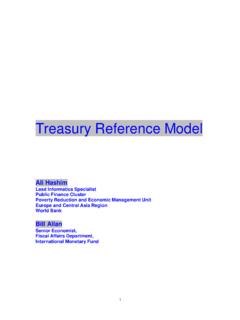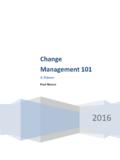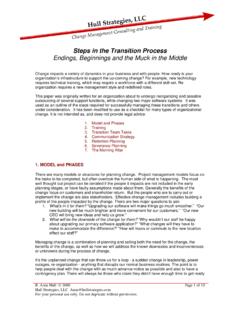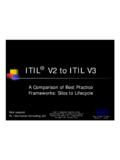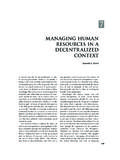Transcription of The New Accounting Model of the Swiss …
1 ISSN 1608-7143 OECD Journal on BudgetingVolume 8 No. 1 OECD 20081 The New Accounting Model of the Swiss ConfederationbyThe Federal Finance Administration*Switzerland s public Accounting system has been completely overhauled. The NewAccounting Model for the confederation was used for the first time to prepare the 2007budget and the 2008-10 financial plan. This article examines the fundamental newdirections of financial management in Switzerland.* This article was originally published in German in September 2006 and is available NEW Accounting Model OF THE Swiss CONFEDERATIONOECD JOURNAL ON BUDGETING VOLUME 8 No. 1 ISSN 1608-7143 OECD 20082 Executive summaryIn light of the growing demands on financial management, the decision was taken tooverhaul the Swiss confederation s Accounting system. The New Accounting Model (NAM) in use for the first time in the 2007 budget and the 2008-10 financial plan contains twofundamentally new of all, the New Accounting Model takes a dual perspective in presenting theConfederation s financial processes and circumstances.
2 For overall fiscal policymanagement in accordance with the debt containment rule, which requires a balancebetween revenue and expenditure, the cash or financing aspect remains the focal is conveyed in the financing and cash flow statement. However, in terms ofadministrative and operational management, the performance aspect now takes centrestage. As in the private sector, this is displayed in the income statement and supplementedwith operational cost Accounting . This makes a substantial contribution to ensuring theefficient and effective use of , the confederation s financial reporting under the NAM is based on theInternational Public Sector Accounting Standards (IPSAS), the only comprehensive andgenerally accepted set of guidelines for the public sector. This ensures transparency andcontinuity in financial reporting, producing more meaningful financial , the new Accounting structure and the transition to business-orientedaccounting practices brings the confederation closer to the Accounting standards of otherpublic authorities and the private sector, thereby improving comparability.
3 In turn,transparency and comparability facilitate the job of financial management and helpgenerate confidence among the overhaul of the Accounting system simultaneously affects the accounts structure,the preparation of accounts, budget management and financial reporting, as outlinedbelow in the main features of the New Accounting accounts structure is more or less based on the Model used in private industry,comprising the income statement, the balance sheet, and the financing and cash flowstatement. The income statement, which is drawn up at the level of the administrative unitand consolidated at federal level, is now an important element in the financial statementof the confederation . It forms the basis for the appropriation of credits and for deriving thefinancing approach. The income statement compares expenses (decrease in value) fromone Accounting year with the corresponding revenue (increase in value), showing in itsbalance the net surplus, which is posted in the balance sheet as profit or balance sheet provides information on the confederation s asset and capitalstructure and shows in its balance the accumulated deficit from the previous years (orequity in the case of a surplus).
4 Its layout has changed only slightly under the , the balance sheet is now drawn up at the level of the administrative unit for thefirst NEW Accounting Model OF THE Swiss CONFEDERATIONOECD JOURNAL ON BUDGETING VOLUME 8 No. 1 ISSN 1608-7143 OECD 20083 The financing and cash flow statement (FCFS) is used for calculating overall financingrequirements. In its financing section basically like in the old financing statement itshows receipts and expenditures and is therefore of particular importance in overall fiscalpolicy management, which seeks to balance the budget. The FCFS is derived from theincome statement and the balance sheet and disclosed for the confederation as a , investments are posted separately at the level of the administrative units forthe purpose of appropriating credits a characteristic feature of public Accounting .
5 (As thisinvolves flows of funds, Parliament has to be able to determine investment expenditure toensure it remains within the debt containment rule.) Investments are combined with theitems from the income statement to form what is known as the credit , Accounting and financial reporting are carried out under the NAM inaccordance with standard business practices, a performance approach. All assetsare now posted in the Accounting period in which they are consumed or created ( accrualaccounting and budgeting ). In addition, events of merely book-entry nature, , are now posted. Now that the balance sheet items are valued inaccordance with the true and fair view generally used in the private sector, whichreplaces the prudence concept from the Code of Obligations, there are a number ofvaluation changes some quite substantial with respect to the old balance management under the NAM follows the dual control principle.
6 Theadministrative units are now managed on the basis of the income statement andstatement of investments as well as operating cost Accounting . Of significance here areboth the fiscal policy criteria of Parliament (budget decision) as well as the business-oriented viewpoint of the administrative units (budget implementation). The systematicdecentralisation of credit responsibility and the introduction of internal service chargespromote a sense of cost awareness and an economical use of funds. Together with theintroduction of the NAM, the FLAG Model (German acronym for management byperformance mandate and global budget ) is extended to numerous other , there are only few changes in terms of overall fiscal policy management,where the financing and cash flow statement continues to play a central role in managingthe debt containment rule ( debt brake ).
7 Likewise, the financial plan remains the centralsteering instrument of the Federal Council and Parliament in setting (fiscal) policypriorities in medium-term task reporting has been given a complete makeover in the NAM, now includingadditional content. It is thus more meaningful than the previous system. Thanks to itsmodular structure, the various stakeholder groups can now quickly gain an overview of theasset, earnings and financial situation of the confederation and, if necessary, access morein-depth the introduction of its formal structure, the NAM project has reached animportant milestone and entered a new phase. This does not bring to an end the variousdevelopments introduced with the NAM to optimise overall fiscal policy management andcreate a new public management system focusing on business-oriented principles. Rather,the NAM should be seen as an ongoing process of learning and adaptation that requiresupdating and practical use to ensure continuous NEW Accounting Model OF THE Swiss CONFEDERATIONOECD JOURNAL ON BUDGETING VOLUME 8 No.
8 1 ISSN 1608-7143 OECD 200841. A new federal Accounting modelIn every organisation, Accounting is a financial reflection of its economic processesand circumstances. Accounting has the role of presenting information of financialrelevance that is needed for the successful management of the organisation. It also servesto provide a wide range of stakeholders with accurate details about the course of businessand the financial impact thereof. Accounting thus serves two fundamental purposes: First, it should render an account to the outside world. Stakeholder groups such asshareholders and creditors, or in the case of the public sector the Parliament, politicalparties and taxpayers, should be told where value has been created or lost in theprevious period, the sources from which money has been received and how this has beenspent, and finally, how the financial situation has evolved over the period.
9 Armed with atransparent, coherent and standardised report and presentation of these facts, therelevant parties can then exert their influence on the future of the organisation withinthe scope of their rights and obligations. In addition, Accounting should also like afinancial diary provide the basis for testing the legality of financial operations. Second, Accounting should support financial and operational management by taking aninward look at the organisation. The availability of detailed and specific informationenables those responsible to steer business processes in accordance with their mandateand to perform them economically. Accounting thus plays a role in internalmanagement and decision basic functions are performed with the help of various systems. What is mostimportant is that the Accounting Model be structured to match the organisation smanagement standards and objectives and to meet the users information turn, these factors depend on the organisation s objectives and mandate and on itsinstitutional Accounting differs between the private and public sectorsIn the private sector, Accounting focuses on the process chain to invest create anduse up value refinance.
10 In other words, profitability and liquidity lie at the centre of allprivate sector actions and decisions. The central elements of Accounting are thus theincome statement, the cash flow statement, the balance sheet and a carefully honedinternal cost in the private sector, the main priority in the public budget, funded in advanceby taxes, is not profit but equilibrium between spending and income. The financingapproach is thus of particular importance. This is especially so in the case of the SwissConfederation, with its high level of transfer spending ( subsidies ) and a relatively lowlevel of operating spending, with a mostly steady level of investment expenditures and abudget size that is relevant in macroeconomic The financing statement: the cornerstone of the old federal Accounting systemIn the past, the federal Accounting system had at its heart its financing shows the revenue and expenditure resulting from the fulfilment of the mandate andsubdivides these further by administrative unit and purpose.










